American Sabbatical 87: 4/7/97
Peanuts, Pecans, and Peaches
4/7... Pecans and peaches.
The work week dawned bright and crisp. Maybe in the low 60s. Peggy still insisted
on a quick dip in the pool. She’d convinced the manager to let
her use it last night, although they hadn’t put in “the right
chemicals.” Or so they said. You get a runaround in a lot of these
spas explaining why the pool isn’t open. Our check-in check-list
is now as long as a preflight check. Nonsmoking rooms? AARP discount?
Pool open? Check? The frog in the pool hadn’t read the sign.
| We were going to prison today. Andersonville. Which had us cutting
east by south from Columbus, and we were out of the urban thrumming
in a wink. Georgia is just as attractive as Alabama, once you
forsake the interstate, and we were so lulled by the red clay
hills and tall timber that we missed our cutoff for the 1860s
and ended up on the road to Jimmy Carter. |
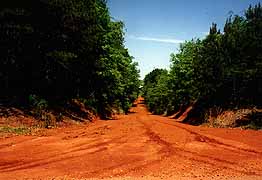
Red Dirt
|
In Richland the first signs of peanut farming rose up out of the
furrows: tall silver barns with high-pitched peaks (we were listening
closely) and fields full of colored nut wagons.. like deep children’s
wagons with long tongues, only 8 feet tall. I pulled down a sidestreet
to where they were pumping nuts into an 18-wheeler out of a galvanized
warehouse. We made drawings like mad as yellow dust plumed out
of the conveyor pipes and drifted to leeward. Another engaging
industrial scene, and we can understand the fascination Sheeler
and (less sympathetically) Hopper had for them. Maybe Thomas Hart
Benson liked them best of all.
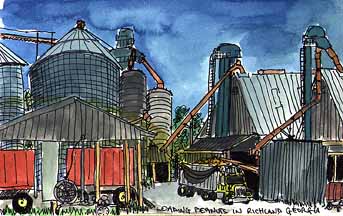
Peanut Packing
(Bryce)
By now the sun was approaching the meridian, although we didn’t
have a clue what the time was. We’d crossed and recrossed the
time line, and daylight savings had kicked in. Is it still today?
The local clocks say noon, so it’s time to eat. A handpainted
billboard advertised sweet-potato pie at Mom’s Kitchen. Now..
we’re the kinda sports who’d play poker with a guy called Doc,
so we stopped for pie at Mom’s.
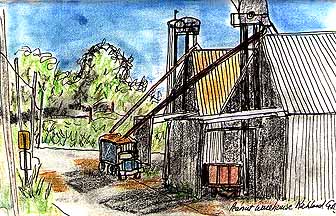
Packing Peanuts
(Peggy)
Boy, was that old saw ever wrong. If you’re ever in Preston, Georgia,
stop for lunch at Mom’s. We went in through the kitchen screen
door, where five women were sweating over the stainless, and were
waved into the diningroom. Small formica tables crammed into your
basic local diner. Primitive art on the walls, and homilies from
The Good Book. Ten commandments. We joined the line at a crooked
array of steam-tables, and dubiously slid our trays toward the
entrees. Unfamiliar vegetables, thick gravy, steaks. But the menu
on the chalkboard says Grilled Quail, so we decide to get one
order, with double biscuits, iced tea, and two slices of that
pie.
Everyone else is moving through like clockwork. Bailiffs from
the county court across the road getting take-out. Elderly couples
howareyooing each other. Field soiled farmers joking in dialect
we can’t penetrate. Folks of all colors looking healthy and acting
convivial. Including us in the banter when we ask about a stuffed
bobcat on the wall. Telling us to watch out for the birdshot in
our quail. Which takes forever to come. But the two men clearing
table keep filling our tea glasses and making small talk so we
don’t gnaw the furniture.
When it comes, the quail is fantastic. One serving is an entire
bird, plenty for two, and the fresh pickled cabbage and black
eyed peas are to live for. All for $8.49. Peggy goes out back
to rave at the cooks, and they grin, like they already know that
it’s just like home. At Mom’s.
It’s very refreshing to be in towns where there’s a mix of class,
but everyone is black. Us Yankees are so used to enclaves of affluent
blacks, or tokenism, and ghettos of urban black poverty. Here
in Dixie class distinctions seem to be less extreme, and people
of color fill all the roles. Where there are whites as well as
blacks, the integration is thorough and easy-going. Mixed couples
and squads of kids along the Chattahoochee, mixed clientele in
all the stores and restaurants, and at Mom’s the black owners
and crew are making all comers feel good about lunch. These are
rural places, to be sure. No doubt we could find racial tension
and defacto segregation in the cities. I remember the invisible
lines in Norfolk. So is it a city thing? Too many rats in the
cage? I think it would be a lot easier to be black in the rural
South, or colorblind. I like it.
| We liked Plains, Georgia, a lot, too. Jimmy’s hometown, and where
he’s chosen to remain, is still a real town in peanut country.
Sure his family has cashed in with Carter tourist traps. But they’re
in the old main street stores, and are as downhome as you could
want. The nut-washing rigs and storage buildings abut the railroad
in the middle of town, in fact they ARE the town. Cultivation
comes up to the few houses that are clustered here. A visitors’
center is a mile down the road, and you can pick up a free self-guided
driving tour, but the places of personal interest are still private.
Wave when you drive by. |
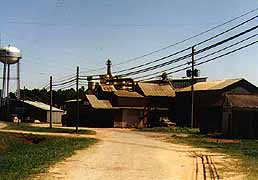
Scene Sheeler
|
President Carter’s boyhood home is as unpretentious as the man
himself, but it is next door to one of those pecan groves that
inspire you to noble thoughts. If I turn up missing, look for
me in a pecan grove. These are tall trees, mind you, sometimes
100 foot, spaced in cathedral rows, each branching widely from
the base and reaching out like inverted cones in perfect gestures
of supplication, covering acres. Their leaves are just spreading
now, and the pasture grass beneath them is deep and glowing. I
slow down as we pass each one, captivated, drawn into the dappled
aisles.
(Memo #80)
April 7 Jimmy Carter’s Habitat
Who? President of the United State 1977-1981
What? his small hometown
Where? central western Georgia
When? Now
How? President's boyhood home and town are organized for tourists
Topics: homegrown presidents, president’s homes, tourism
Questions: What kind of hometown do presidents come from? |
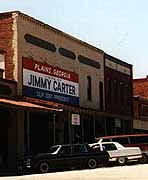
Heart of Plains
|
Plains, Georgia, is a very small town in the middle of rolling
farmland. Groves of lovely pecan trees are interspersed with crop
land and pine forests and dairy herds. In early April it was all
a lush green and a mild breeze was blowing. The houses are low
wood and brick bungalows with deep porches except for a few higher
Victorians in the village. Each nearby town has a peanut warehouse
and peanut “cars” that look like the trolleys in coal mines.
The signs for “Carter Historical Site” begin several miles outside
of town, the houses thicken, then suddenly you’re in the village.
Plains is small. There is basically one stretch of attached false
front wooden stores with a long covered walk in front that looks,
for all the world, like the set for a western movie. It is across
a wide street from the now unused railroad station (identified
as Carter campaign headquarters). On the other side of the tracks
is the main road. A few side roads branch off it. Downtown is
one block. The town is maybe four blocks square.
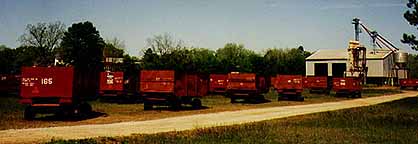
Nut Wagons
Roasted, boiled, candied, chocolate-covered peanuts are offered
for sale. Carter’s uncle gives individualized tours. There is
a self-guided car tour that we drove. We saw Carter’s elementary
school, his church, his modest childhood home outside town, the
graveyard with many Carters in it. The Carter compound is right
downtown which surprised me. There is a fence around it and guarded
gate and trees hide the house itself.
While Carter is the draw for tourists and there were several buses
in Plains, we still got the feeling of a quiet, small town with
a strong identity. Nurses were chatting outside the retirement
home, people were sweeping their yards and unloading groceries
from their cars.
During his 1976 campaign, Carter was identified as “the man from
Plains”, a simple small town boy. Although he had become a nuclear
engineer, an affluent farmer-businessman and experienced politician,
he was cartooned as a hick who didn’t understand Washington. He
was a man who avoided status symbols and the trappings of wealth,
he liked to make furniture and he carried his own bags! He put
his young daughter into public school in Washington D.C. He taught
Sunday school while president! He was interviewed in Playboy where
he admitted he had ”lusted after other women” IN HIS MIND, but
was openly affectionate to his wife and young daughter Amy and
three sons. The Playboy quote was greeted with the derision later
heaped on Clinton for the comment that he smoked but didn’t inhale!
Carter even gave talks on TV dressed in a cardigan. No one dug
up any DIRT on Carter. His fault was that he was TOO moralistic,
TOO idealistic, TOO religious. Too good?
The first indelible photo image of Carter was when he got out
of the presidential limousine and walked hand in hand with his
wife down the avenue during his inaugural parade. Rosalyn was
designated “the iron magnolia”, a lovely, gracious, quiet woman
whom, Carter admitted, he consulted on policy issues and allowed
to sit in Cabinet meetings! Her ladylike demeanor deflected some
of the interfering-woman-inappropriate First Lady behavior criticism
which has been aimed at Hillary Clinton. Funny how the country
forgets how involved Eleanor Roosevelt was in politics, or how
the second Mrs. Wilson actually ran the country after her husband’s
stroke.
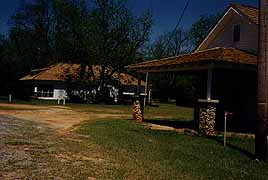
Carter Compound
|
Carter was elected in 1976 when the country was recovering from
Watergate and something different from politics as usual was needed.
He seemed open and honest, totally unlike Nixon. Carter was president
during the oil embargo, energy crisis, and Iran hostage incident.
He lost the 1980 election to Ronald Reagan. I remember that he
was quite often termed a ‘failure” as president in the media. |
I could remember the Camp David Accord. What else had he done
as president? The visitors’ center listed his presidential accomplishments:
creation of a Department of Energy and Department of Education,
deregulation of the transportation industry, passage of the Alaska
lands Act (113.5 million acres), and the National Parks Act (which
added 15 sites, among them Lowell Industrial Park and Seneca Falls,
both sites I visited and enjoyed immensely). He created the Superfund
for toxic waste cleanup, a Homeowners’ Tax Credit for weatherproofing
and retrofitting houses. He negotiated the Salt 2 Treaty, the
Panama Canal Treaty, and the Camp David Accords. He recognized
the People’s republic of China. Lastly he negotiated the release
of the Iran hostages (which took place several hour after he left
office).
After 1981, he left politics and went back to Plains. He has quietly
and effectively gone about the work he believes in. He is greatly
involved with Habitat for Humanity, an organization with a huge
headquarters nearby in Americus, Georgia, that builds and refits
low cost housing for Americans, and has been photographed hammer
in hand working on their projects. He has been an observer in
many foreign elections for the U.N. He seems - in fact - quite
like his hometown, quiet and unassuming and attractive, basically
good.
Driving away from Plains I thought about the smalls towns which
produce presidents. Hope, Abilene, Independence, Springfield,
Quincey (Clinton, Eisenhower, Truman, Lincoln, the Adamses). In
a small town, people know you. You learn people skills, you learn
to maintain a network, you amass local knowledge, you practice
small talk, you have to get along.
4/7.. contd.
| After the drive-by, Red and his people carry on for Andersonville, admiring the
scenery. The carrion birds hereabout are those hideously ugly
red-headed vultures. We’ve discovered that the mounds of dirt
by the road are made by fire-ants. The atmosphere takes on a less
charming aspect. Or is that our historical imagination? |
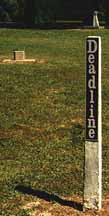
Signs
|
The Andersonville prison rides a high ridge and is totally exposed
to the eyes of heaven. I was surprise to find it still an active
military cemetery. In fact a funeral was in progress among the
row after row of WWII and Korean War and Vietnam War graves. State
monuments commemorating Civil War dead, with granite or bronze
sculpture atop plinths, stand up among the regiments of marble
headstones. A Parks Service crew was painting and waxing Wisconsin,
but weren’t amused by my levity. So I came back to earth. The
State of Georgia monument was of three prisoners in tatters supporting
each other, and is dedicated to all prisoners of war, in whatever
time and place. You can’t do better than that.
(Memo #81)
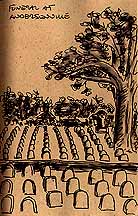
A Funeral at Andersonville
|
April 7 Andersonville
Who? Union soldiers, prisoners of war
What? infamous Civil War prison camp with huge mortality rate
Where? central Georgia
When? 1864-65
How? overcrowding, disease, malnutrition
Topics: POWs, Civil War
Questions: Why were conditions so bad at Andersonville? |
All wars produce atrocities. All wars produce prisoners of war.
All wars produce places where prisoners are kept - stalags or
prison ships or compounds. What sets Andersonville apart from
others, even in the Civil War, was the incredible number of deaths,
almost 13,000 out of 45,000 prisoners. And in only fourteen months.

Andersonville
Andersonville is in central Georgia, a huge open clearing cut
in the pine woods. Today there is a national graveyard adjacent
to it. A funeral was going on in the new section. In the Civil
War section the headstones touch, forming unbroken lines that
stretch over huge expanses of lawn, testament to the hideous prisoner
mortality. There are brick walls and statuary in the national
cemetery, and a few monuments in the prison compound area. Two
corners of the stockade have been reconstructed with “pigeon roosts”
(guard towers) and the huge double gates. The outline of the stockade
and the dead line (across which prisoners couldn’t venture) are
marked by spaced white stakes. Mainly it is quiet open grassy
land.
| Andersonville was not designed as a death camp. At first no one
expected the war to last, so POW camps were unnecessary. At the
beginning of the war prisoners were released on “parole” (their
oath that they wouldn’t fight again). In 1862 the Dix-Hill Cartel
outlined exchanges of prisoners (the worth of a prisoner related
to his rank). In April 1964 General Grant prohibited further exchanges
feeling that they were prolonging the war (the North had ample
manpower to spare, the South didn’t). He was partly to blame for
Andersonville since his prohibition lead to the overcrowding of
the existing camps. |
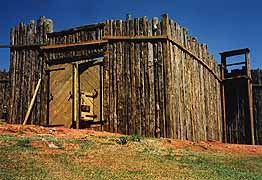
Gate
|
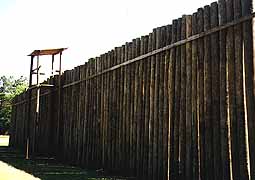
Stockade
|
Andersonville was constructed in central Georgia for several reasons:
it was adjacent to a railroad line, remote from the front lines,
in a warm climate, near an agricultural region which would provide
food, and a forest which would provide building materials. And
the tiny population would not effectively oppose the camp. Slaves
cleared the forest and enclosed sixteen and a half acres with
a stockade made of 20 foot high, foot diameter logs set five feet
into the ground. There were fifty two guard towers. Ten thousand
prisoners were supposed to live within those sixteen and a half
acres. Eventually the stockade area was increased to twenty six
acres, BUT over 33,000 men were crowded into that space during
the camp’s peak! |
| Water and hygiene were major problems. A small stream went through
the camp, but was polluted from the upstream guard camp and camp
latrines. Prisoners tried to dig wells (some are still visible).
The “Providence Spring” appeared after much prayer when a lightning
bolt hit the ground. The spring is enclosed in a stone memorial
shelter now. There was no fuel for the cold, no permanent shelter
from the heat (which we felt even in early April), The prisoners
made “shebangs” out of blankets and ponchos and clothing. Prisoners
were to get a quarter of a pound of cornmeal and a half pound
of bacon or beef a day. As the war progressed, scarcity in the
South meant fewer rations. Deaths mounted from malnutrition, typhus,
diarrhea, sunstroke. There were twenty-two hospital sheds eventually
with fifty men in each, but the doctors had few supplies and improvised
a great deal. |
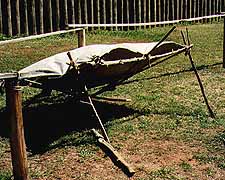
Shebang
|
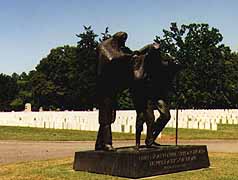
POW Memorial
|
The men kept busy with games (chess, checkers, dice, cards), storytelling,
crafts. Some were taken out on work details (and managed to bring
back firewood). Slightly over three hundred escaped, but most
escapees were caught by the guard dogs. A few managed to created
items for barter. There was also theft and violence as a group
of inmates called “Raiders” took control of the camp. Guards and
inmates banded together in response. The Union sergeants in camp
tried the accused Raiders and six inmates were hanged by fellow
Union soldiers for their crimes against other inmates. |
When Andersonville was “liberated” at the end of the war, northerners
were horrified by the reports of camp conditions and mortalities.
The Assistant Superintendent of the camp Henry Wirz was tried
in Washington and hanged for war crimes. When Southerners were
attacked about Andersonville, they would counter with the names
of infamous Northern POW camps (especially Rock Island, Illinois).
In fact, the mortality rate of Southern POWs was 12%, of Northern
POWS it was 15.5%. There were Civil war prison camps at Cahaba,
Ala., Oglethorpe, Ga., Salisbury, S.C., Belle Isle, Va., Libby
Prison, Va., Camp Butler, Il., Camp Douglas, Il., Camp Morton.
Il., Johnson Island, OH., Camp Charles, OH., Elmira, N.Y., and
Ft. Lookout, MD. I don’t know if any others are national historical
sites.
|
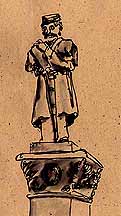
Maine Memorial
|
Andersonville is a somber place. The great hillside bears few
scars of the misery and death and there was a bright sun shining.
But we still felt chilled. We drove north from Andersonville through
the rolling farmland. Soon we saw a modern prison off to the left.
There were round space age guard towers and the barbed wire on
top of the high walls gleamed in the sun.
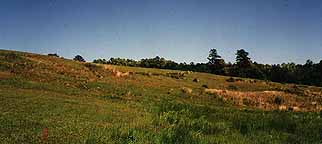
Andersonville
4/7.. contd.
After Peggy filled her notebook and laid hands on the hand-outs, we swung east and north, marching
for the Ocmulgee Mounds outside Macon. But the misery of Andersonville
is still spread on the landscape nearby. From the heights of the
camp you can see two gigantic industrial complexes with smokestacks
belching. Georgia Pacific and what looks to be a gypsum or cement
plant. Then, just down the road, the Macon Penitentiary, with
coils of razor wire atop the cyclone fences, space age guard towers,
and a free-fire zone. Plus ca change...
Then the pecans sooth us again. And the PEACHES. Miles and miles
of peach orchard. They don’t put those orange balls on the license
plate for nothing. What it must be like in March, when they are
all in bloom! Right now those vagrant imports, the chinaberries,
are sweetening the air with their cloying perfume along every
untended woodlot. I can’t figure if they were planed as ornamentals,
or for some control purpose (their twigs and berries are toxic
to some plants, and us), or if they have opportunistically leapfrogged
along the roads just to scent the air.
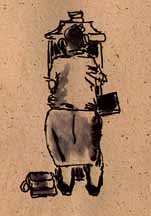
Phone Home
|
Homeemade peach ice cream. Yes, M’am, we’ll have two. And isn’t
it fine? With little chunks of fruit in every scoop. We sit on
the peach factory rockers watching the sun scale down, trading
pleasantries with two elderly black ladies, who say this is the
best peach ice cream in the county. I could stand a lot of this.
But I don’t have to stand too much more today. Ocmulgee has closed
until tomorrow, and we sidle into Macon, looking for another pool
and a friendly phone jack. |
















